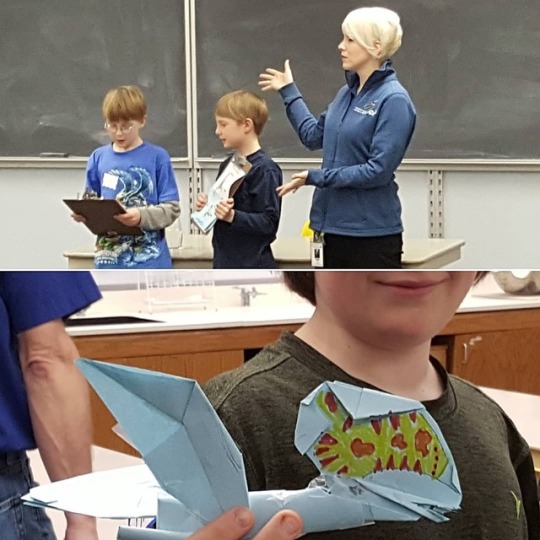#pterosaurptuesday
Explore tagged Tumblr posts
Photo

Happy #PterosaurPtuesday! Steps to Becoming a Fossil 1. Live 2. Die (gracefully, and in shallow water, if possible) 3. Get covered by only the finest of sediments 4. Lay still until someone finds you This beautifully preserved 150 million year old juvenile #Pterodactylus antiquus was found in the limestone layers of Solnhofen, Germany, where fossils like Archaeopteryx were discovered. Exquisitely preserved and articulated fossils like this are essential to helping us understand what these organisms looked like when they were alive. See this REAL fossil in person at Pterosaurs: Flight in the Age of Dinosaurs now through August 12th @gocmnh! (at Cleveland Museum of Natural History)
75 notes
·
View notes
Photo

Day 15: Pterosaur. I was about do something special for #PterosaurTuesday on Inktober and this time, I went to sketch and inked the new pterosaur of 2019 that was already discovered and named this specie Ferrodraco lentoni from down-under such as Australia. I hope of you enjoyed. Based on skeletal design by SassyPaleoNerd. #pterosaur #pterosaurptuesday #pterosaurs #inktober #inktober2019 #paleoart #inkdrawings #myart #paleoartist https://www.instagram.com/p/B3qdDuClUeA/?igshid=1xrp73q9tkhe2
#pterosaurtuesday#pterosaur#pterosaurptuesday#pterosaurs#inktober#inktober2019#paleoart#inkdrawings#myart#paleoartist
0 notes
Photo

More #PterosaurPtuesday goodness from @paleeoguy! ------------------ Time for #PterosaurPtuesday! Here is a reconstruction of #Tapejara, an Early Cretaceous crested #pterosaur genus from Brazil's Romualdo Formation. This slab is about 1 m (3 ft) in height. Currently on display @goCMNH!
32 notes
·
View notes
Photo

A pterosaur so nice it fossilized TWICE! I missed #PterosaurPtuesday this week, so I'm coming at'cha with a double whammy! This young #Pterodactylus antiquus was found in Solnhofen, Germany. If the location sounds familiar, that's because that's where the famous Archaeopteryx lithographica specimen was found! Why was this specimen preserved twice? The actual fossil skeleton is on the right. The counterslab on the left is the impression that the skeleton left behind in the soft sediment. When this specimen was discovered, it was cracked in half, revealing the specimen AND it's impression, inside. Specimen no. AMNH1942 Solnhofen, Germany Late Jurassic (at Cleveland Museum of Natural History)
8 notes
·
View notes
Photo

Happy #PterosaurPtuesday! Did you know that the pterosaurs you know and love had hollow bones? What does this mean? In both birds and pterosaurs, who are distant cousins, the thin walls of the bones increase the strength of the skeleton without adding additional weight. The bones during life were also filled with air, aiding in respiration during life. Now, just because pterosaurs had hollow bones doesn't mean they were fragile, super light animals. Pterosaurs were extremely muscular which would have added mass and power. Anyone who has had a chance to hold a bird of prey knows this! During fossilization, calcite crystals grew in this 110 million year old pterosaur wing bone helping better preserve this fragile specimen [while making it look super cool at the same time]. This specimen was found in a concretion, which also helped it stay preserved. This fossil AND MORE can be seen in the traveling exhibition from @amnh, Pterosaurs: Flight in the Age of Dinosaurs, now @gocmnh though August 12, 2018! #pterosaur #cle #pterosaurs #fossil #calcite #crystal #cleveland #notadinosaur #museumcollections #ilovemuseums #naturalhistory #ohio (at Cleveland Museum of Natural History)
#ilovemuseums#cleveland#museumcollections#pterosaur#naturalhistory#crystal#fossil#pterosaurs#notadinosaur#calcite#pterosaurptuesday#cle#ohio
2 notes
·
View notes
Photo

Happy #PterosaurPtuesday! My homeschool class researched pterosaurs in @AMNH's Pterosaurs exhibition & then expressed what they researched in several creative ways! Check out this group's paper #Tupandactylus model! #museumed #wearescience #scicomm #pterosaur #stem #learn #themoreyouknow #notadinosaur #homeschooling #museumsmatter (at Cleveland Museum of Natural History)
#pterosaur#tupandactylus#museumed#wearescience#museumsmatter#learn#notadinosaur#scicomm#themoreyouknow#homeschooling#pterosaurptuesday#stem
5 notes
·
View notes
Photo

Happy #PterosaurPtuesday Which pterosaur was the largest, and the largest vertebrate to ever fly? Quetzalcoatlus northropi! Discovered in 1971 at Big Bend National Park in Texas by then graduate student Douglas Lawson, this enormous azhdarchid pterosaur has flown into our hearts and minds. [Cheesy, I know!] Could giant azhdarchid pterosaurs fly? Science says YES! Pterosaurs had hollow bones, so even the largest pterosaurs at 200kg were light on their 30 foot wingspan, and as paleontologists Mike Habib and Mark Witton estimate, able to fly up to 80 miles an hour for 7 to 10 days at possible altitudes of 15,000 feet. Get you some science! https://www.ncbi.nlm.nih.gov/pmc/articles/PMC2981443/ (at Cleveland, Ohio)
10 notes
·
View notes
Photo

HAPPY #PterosaurPtuesday from a tiny baby Ctenochasma! This specimen fits in the palm of your hand. SO CUTE! (at Cleveland Museum of Natural History)
43 notes
·
View notes